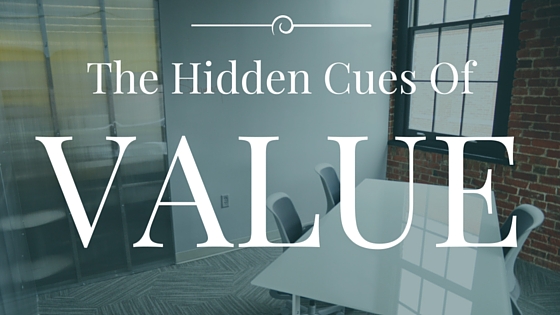
The Hidden Cues of Value

The hidden cues of value
Our financial planning business has an architectural firm as clients. I visited them in their office the other day and was impressed by what I saw.
I guess if you’re an architect it could be hard to sell your value to some clients. A lot of what you’re selling is intangible. The plans you draw up may look ok, but how can I be sure the building you’re designing will look good once it’s built?
How do I know that you can do the job I’m asking you to do? What’s the risk if I pick you and it turns out to be the wrong decision?
This firm has some smart ways to help the client feel at ease and relaxed with their ability.
When you walk into their office, the reception area is modern and stylish. The seats are comfortable (there’s nothing worse than having to sit in a waiting room on an uncomfortable seat). Their receptionist is well presented and polite. She asks if I’d like a tea or coffee and lets me know when she’s told my clients I’ve arrived.
The colour scheme is modern without being too over-the-top. Instead of the usual paintings on the wall, they display photos of the buildings they’ve designed. In the past they’ve had framed architectural drawings on the walls. Thinking about this point they seem to change the wall art every 6 months or so – perhaps a subtle indication to clients that they’re progressive and always looking for new ideas?
They’re boardroom is well laid out – again the artwork on the wall consists of photos of their successful projects and framed drawings.
This business has worked on a range of high profile projects here in Adelaide. Because the photos provide images of such a range of projects, most clients would see a picture of at least one building that they’d know of and be familiar with. This firm has worked on that building. What a great way to build credibility.
Finally, the offices look great. Whilst clients would usually only spend time in the front boardroom and interview offices, today I got to look behind the scenes and I was impressed. You expect an architectural firm to have good looking offices, but so often only the public areas look great. Not with this firm. Their back office area looked great and provides a fantastic environment for their employees to work and learn in.
The overall impression you get from visiting this firm is that of quality. You see the evidence of their past work, the care they take in designing their own appearance and you walk away with the confidence that they can help you with your project.
How do you show prospective clients that you’re good at what you do?
Are you able to show examples of your work? Does your work environment look professional and convey the right image? Or does it show that you’re out of touch and don’t care about your staff?
Think about the first impressions a client receives when they enter your office. What do they think when they first walk in?
Have a think about how they’re greeted – who does the greeting, do you script what they say?
One financial planning firm I used to visit had a sign on their front desk that said ‘Welcome Mr & Mrs Client Name’ – they updated it before each scheduled appointment. When the clients walked in they immediately felt special.
Another business invested in a good coffee machine and created a menu of all the drink options ranging from water, soft drinks to different teas and coffees.
New clients are always looking for clues about the quality of the service and these little ideas help them feel more confident in the person they’re dealing with.
Do this exercise. Pretend you’re a new client visiting your business for the first time. What’s the experience like? What do your premises say about your business?
Have a think this week about the experience of visiting your office. Is it good or bad? How can you improve it?


0 Comments
Trackbacks/Pingbacks